Report: Comparative Corporate Governance in Global Business Context
VerifiedAdded on 2023/06/05
|8
|1782
|296
Report
AI Summary
This report provides a comparative analysis of corporate governance practices in China, Australia, and South Korea. It examines the corporate control models adopted by each country, highlighting the influence of their fiscal, societal, and legal structures. The report delves into the differences and similarities between China and Australia, focusing on the insider-based versus outsider-based approaches to corporate governance, and the role of state-owned enterprises (SOEs). It also compares South Korea and Australia, exploring the evolution of corporate governance in South Korea, including the rise of independent directors and changes in stock ownership, and contrasts it with the Australian model. Finally, it provides a brief comparison of China and South Korea, emphasizing their respective approaches to stakeholder privileges, executive involvement, and the role of committees. The report concludes by emphasizing the importance of understanding these global corporate governance practices for students seeking professional and personal development in the context of international business.
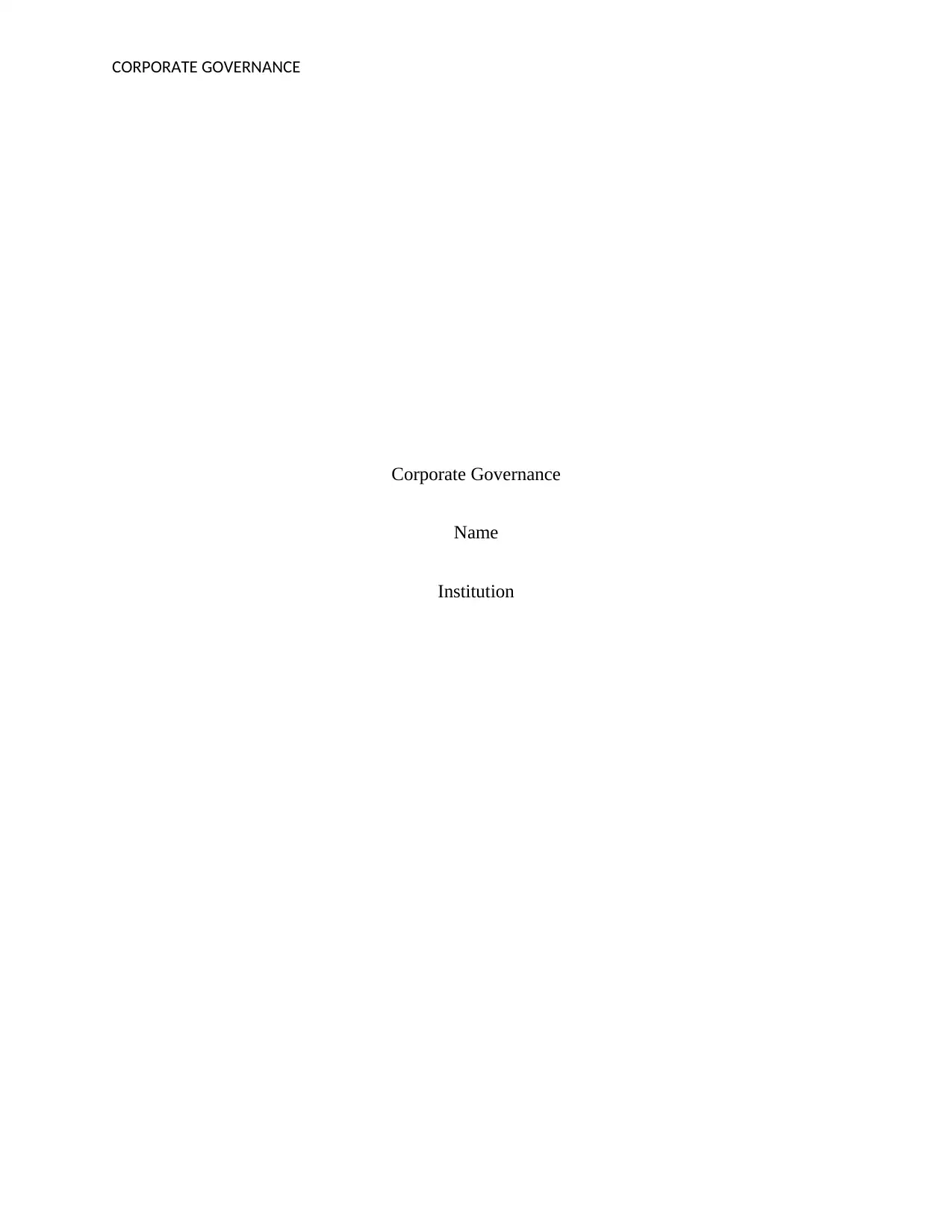
CORPORATE GOVERNANCE
Corporate Governance
Name
Institution
Corporate Governance
Name
Institution
Paraphrase This Document
Need a fresh take? Get an instant paraphrase of this document with our AI Paraphraser
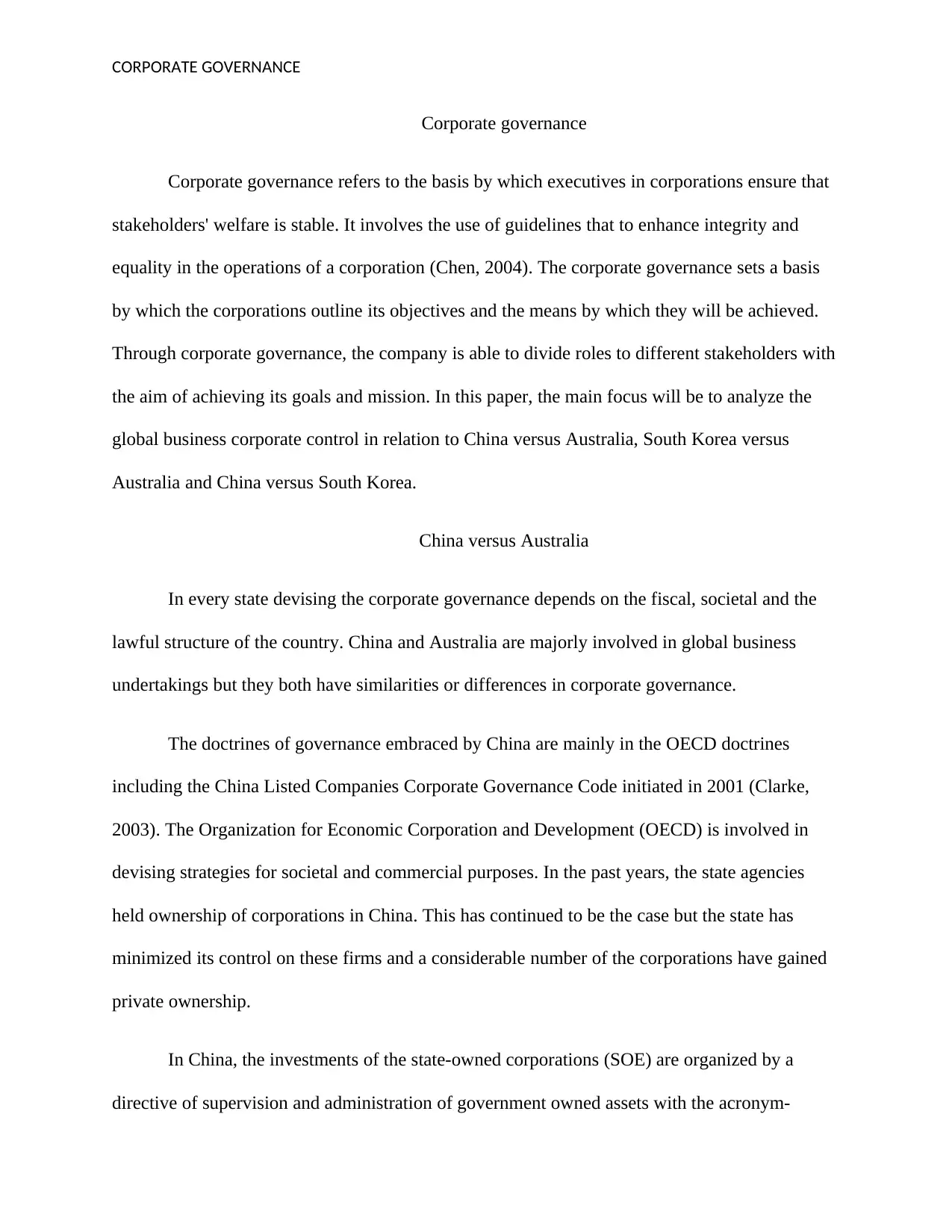
CORPORATE GOVERNANCE
Corporate governance
Corporate governance refers to the basis by which executives in corporations ensure that
stakeholders' welfare is stable. It involves the use of guidelines that to enhance integrity and
equality in the operations of a corporation (Chen, 2004). The corporate governance sets a basis
by which the corporations outline its objectives and the means by which they will be achieved.
Through corporate governance, the company is able to divide roles to different stakeholders with
the aim of achieving its goals and mission. In this paper, the main focus will be to analyze the
global business corporate control in relation to China versus Australia, South Korea versus
Australia and China versus South Korea.
China versus Australia
In every state devising the corporate governance depends on the fiscal, societal and the
lawful structure of the country. China and Australia are majorly involved in global business
undertakings but they both have similarities or differences in corporate governance.
The doctrines of governance embraced by China are mainly in the OECD doctrines
including the China Listed Companies Corporate Governance Code initiated in 2001 (Clarke,
2003). The Organization for Economic Corporation and Development (OECD) is involved in
devising strategies for societal and commercial purposes. In the past years, the state agencies
held ownership of corporations in China. This has continued to be the case but the state has
minimized its control on these firms and a considerable number of the corporations have gained
private ownership.
In China, the investments of the state-owned corporations (SOE) are organized by a
directive of supervision and administration of government owned assets with the acronym-
Corporate governance
Corporate governance refers to the basis by which executives in corporations ensure that
stakeholders' welfare is stable. It involves the use of guidelines that to enhance integrity and
equality in the operations of a corporation (Chen, 2004). The corporate governance sets a basis
by which the corporations outline its objectives and the means by which they will be achieved.
Through corporate governance, the company is able to divide roles to different stakeholders with
the aim of achieving its goals and mission. In this paper, the main focus will be to analyze the
global business corporate control in relation to China versus Australia, South Korea versus
Australia and China versus South Korea.
China versus Australia
In every state devising the corporate governance depends on the fiscal, societal and the
lawful structure of the country. China and Australia are majorly involved in global business
undertakings but they both have similarities or differences in corporate governance.
The doctrines of governance embraced by China are mainly in the OECD doctrines
including the China Listed Companies Corporate Governance Code initiated in 2001 (Clarke,
2003). The Organization for Economic Corporation and Development (OECD) is involved in
devising strategies for societal and commercial purposes. In the past years, the state agencies
held ownership of corporations in China. This has continued to be the case but the state has
minimized its control on these firms and a considerable number of the corporations have gained
private ownership.
In China, the investments of the state-owned corporations (SOE) are organized by a
directive of supervision and administration of government owned assets with the acronym-
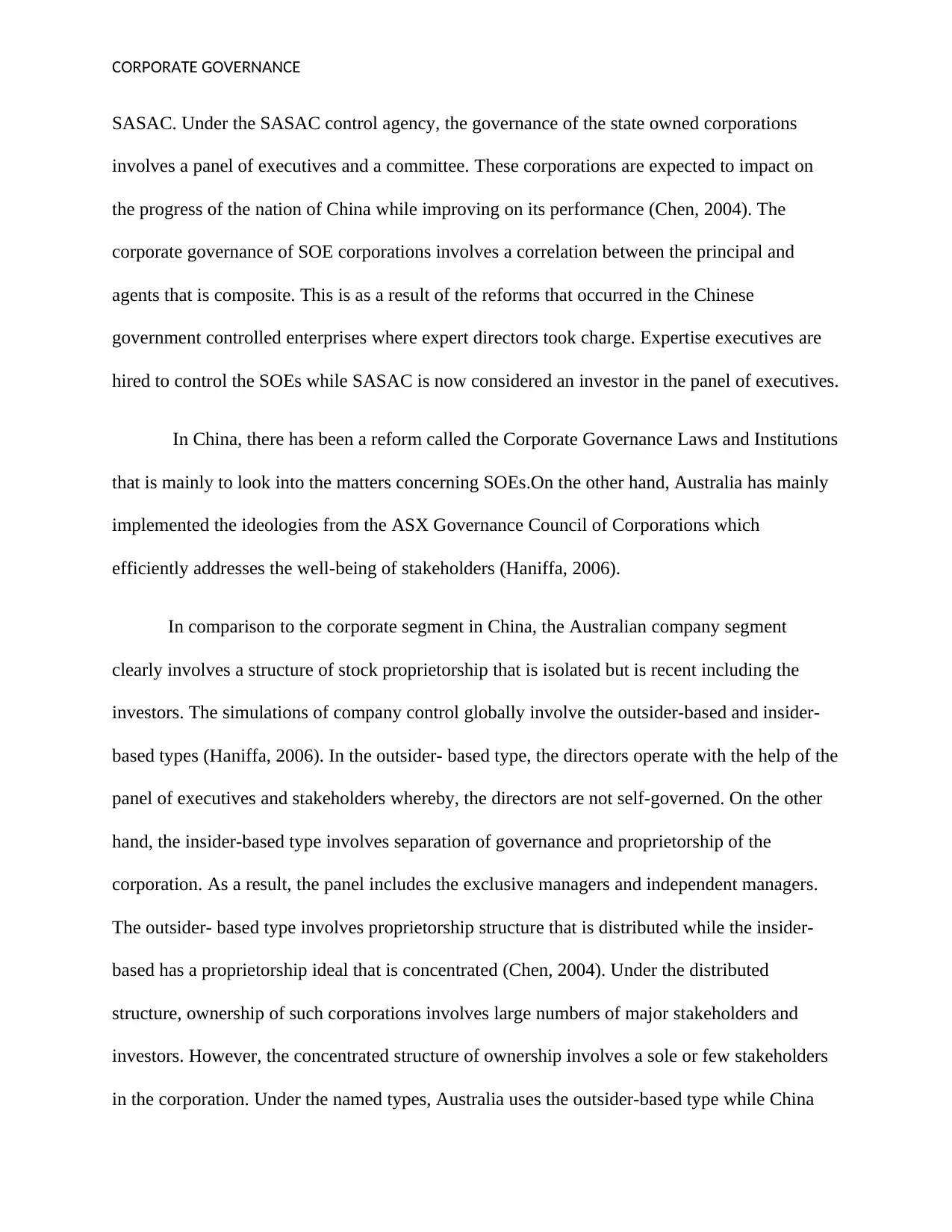
CORPORATE GOVERNANCE
SASAC. Under the SASAC control agency, the governance of the state owned corporations
involves a panel of executives and a committee. These corporations are expected to impact on
the progress of the nation of China while improving on its performance (Chen, 2004). The
corporate governance of SOE corporations involves a correlation between the principal and
agents that is composite. This is as a result of the reforms that occurred in the Chinese
government controlled enterprises where expert directors took charge. Expertise executives are
hired to control the SOEs while SASAC is now considered an investor in the panel of executives.
In China, there has been a reform called the Corporate Governance Laws and Institutions
that is mainly to look into the matters concerning SOEs.On the other hand, Australia has mainly
implemented the ideologies from the ASX Governance Council of Corporations which
efficiently addresses the well-being of stakeholders (Haniffa, 2006).
In comparison to the corporate segment in China, the Australian company segment
clearly involves a structure of stock proprietorship that is isolated but is recent including the
investors. The simulations of company control globally involve the outsider-based and insider-
based types (Haniffa, 2006). In the outsider- based type, the directors operate with the help of the
panel of executives and stakeholders whereby, the directors are not self-governed. On the other
hand, the insider-based type involves separation of governance and proprietorship of the
corporation. As a result, the panel includes the exclusive managers and independent managers.
The outsider- based type involves proprietorship structure that is distributed while the insider-
based has a proprietorship ideal that is concentrated (Chen, 2004). Under the distributed
structure, ownership of such corporations involves large numbers of major stakeholders and
investors. However, the concentrated structure of ownership involves a sole or few stakeholders
in the corporation. Under the named types, Australia uses the outsider-based type while China
SASAC. Under the SASAC control agency, the governance of the state owned corporations
involves a panel of executives and a committee. These corporations are expected to impact on
the progress of the nation of China while improving on its performance (Chen, 2004). The
corporate governance of SOE corporations involves a correlation between the principal and
agents that is composite. This is as a result of the reforms that occurred in the Chinese
government controlled enterprises where expert directors took charge. Expertise executives are
hired to control the SOEs while SASAC is now considered an investor in the panel of executives.
In China, there has been a reform called the Corporate Governance Laws and Institutions
that is mainly to look into the matters concerning SOEs.On the other hand, Australia has mainly
implemented the ideologies from the ASX Governance Council of Corporations which
efficiently addresses the well-being of stakeholders (Haniffa, 2006).
In comparison to the corporate segment in China, the Australian company segment
clearly involves a structure of stock proprietorship that is isolated but is recent including the
investors. The simulations of company control globally involve the outsider-based and insider-
based types (Haniffa, 2006). In the outsider- based type, the directors operate with the help of the
panel of executives and stakeholders whereby, the directors are not self-governed. On the other
hand, the insider-based type involves separation of governance and proprietorship of the
corporation. As a result, the panel includes the exclusive managers and independent managers.
The outsider- based type involves proprietorship structure that is distributed while the insider-
based has a proprietorship ideal that is concentrated (Chen, 2004). Under the distributed
structure, ownership of such corporations involves large numbers of major stakeholders and
investors. However, the concentrated structure of ownership involves a sole or few stakeholders
in the corporation. Under the named types, Australia uses the outsider-based type while China
⊘ This is a preview!⊘
Do you want full access?
Subscribe today to unlock all pages.

Trusted by 1+ million students worldwide
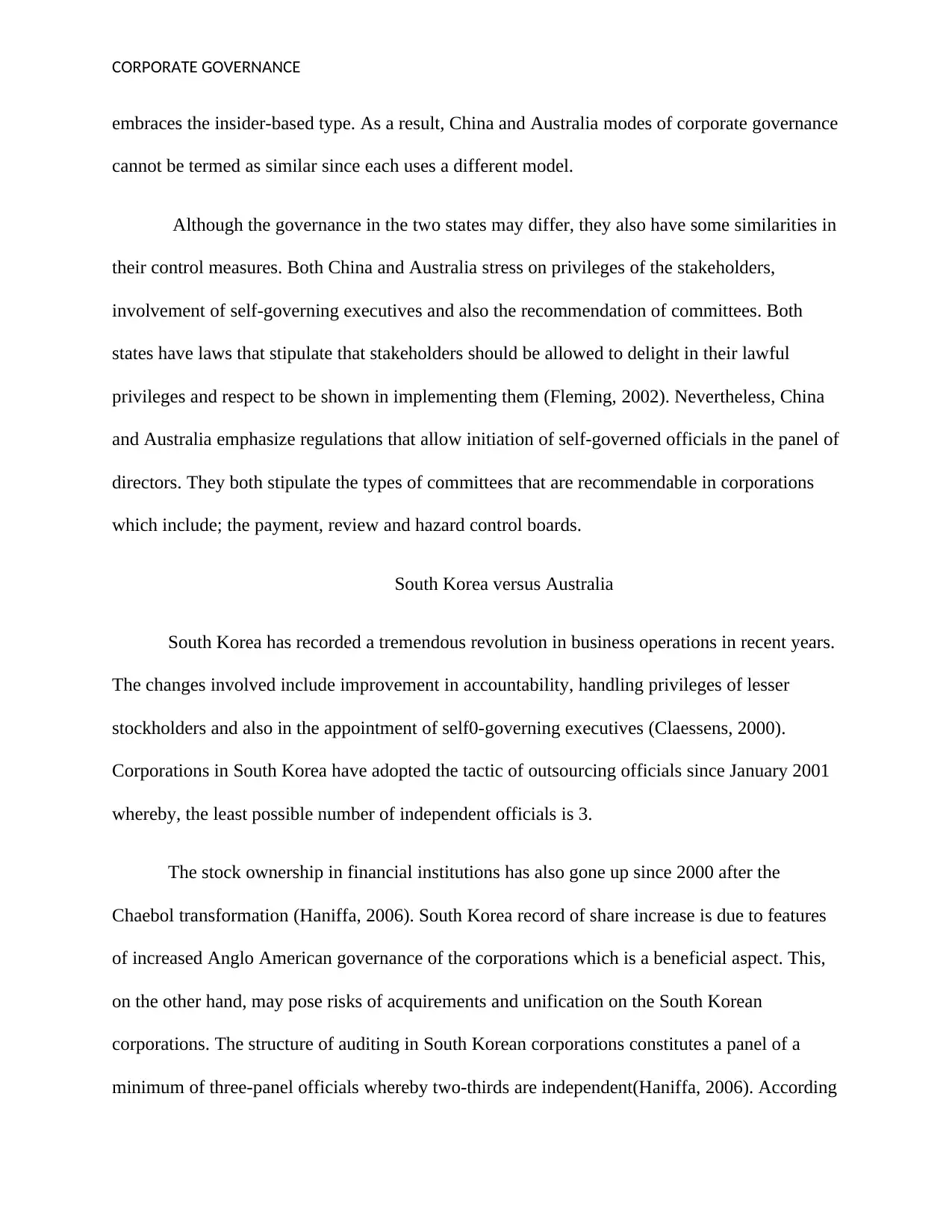
CORPORATE GOVERNANCE
embraces the insider-based type. As a result, China and Australia modes of corporate governance
cannot be termed as similar since each uses a different model.
Although the governance in the two states may differ, they also have some similarities in
their control measures. Both China and Australia stress on privileges of the stakeholders,
involvement of self-governing executives and also the recommendation of committees. Both
states have laws that stipulate that stakeholders should be allowed to delight in their lawful
privileges and respect to be shown in implementing them (Fleming, 2002). Nevertheless, China
and Australia emphasize regulations that allow initiation of self-governed officials in the panel of
directors. They both stipulate the types of committees that are recommendable in corporations
which include; the payment, review and hazard control boards.
South Korea versus Australia
South Korea has recorded a tremendous revolution in business operations in recent years.
The changes involved include improvement in accountability, handling privileges of lesser
stockholders and also in the appointment of self0-governing executives (Claessens, 2000).
Corporations in South Korea have adopted the tactic of outsourcing officials since January 2001
whereby, the least possible number of independent officials is 3.
The stock ownership in financial institutions has also gone up since 2000 after the
Chaebol transformation (Haniffa, 2006). South Korea record of share increase is due to features
of increased Anglo American governance of the corporations which is a beneficial aspect. This,
on the other hand, may pose risks of acquirements and unification on the South Korean
corporations. The structure of auditing in South Korean corporations constitutes a panel of a
minimum of three-panel officials whereby two-thirds are independent(Haniffa, 2006). According
embraces the insider-based type. As a result, China and Australia modes of corporate governance
cannot be termed as similar since each uses a different model.
Although the governance in the two states may differ, they also have some similarities in
their control measures. Both China and Australia stress on privileges of the stakeholders,
involvement of self-governing executives and also the recommendation of committees. Both
states have laws that stipulate that stakeholders should be allowed to delight in their lawful
privileges and respect to be shown in implementing them (Fleming, 2002). Nevertheless, China
and Australia emphasize regulations that allow initiation of self-governed officials in the panel of
directors. They both stipulate the types of committees that are recommendable in corporations
which include; the payment, review and hazard control boards.
South Korea versus Australia
South Korea has recorded a tremendous revolution in business operations in recent years.
The changes involved include improvement in accountability, handling privileges of lesser
stockholders and also in the appointment of self0-governing executives (Claessens, 2000).
Corporations in South Korea have adopted the tactic of outsourcing officials since January 2001
whereby, the least possible number of independent officials is 3.
The stock ownership in financial institutions has also gone up since 2000 after the
Chaebol transformation (Haniffa, 2006). South Korea record of share increase is due to features
of increased Anglo American governance of the corporations which is a beneficial aspect. This,
on the other hand, may pose risks of acquirements and unification on the South Korean
corporations. The structure of auditing in South Korean corporations constitutes a panel of a
minimum of three-panel officials whereby two-thirds are independent(Haniffa, 2006). According
Paraphrase This Document
Need a fresh take? Get an instant paraphrase of this document with our AI Paraphraser
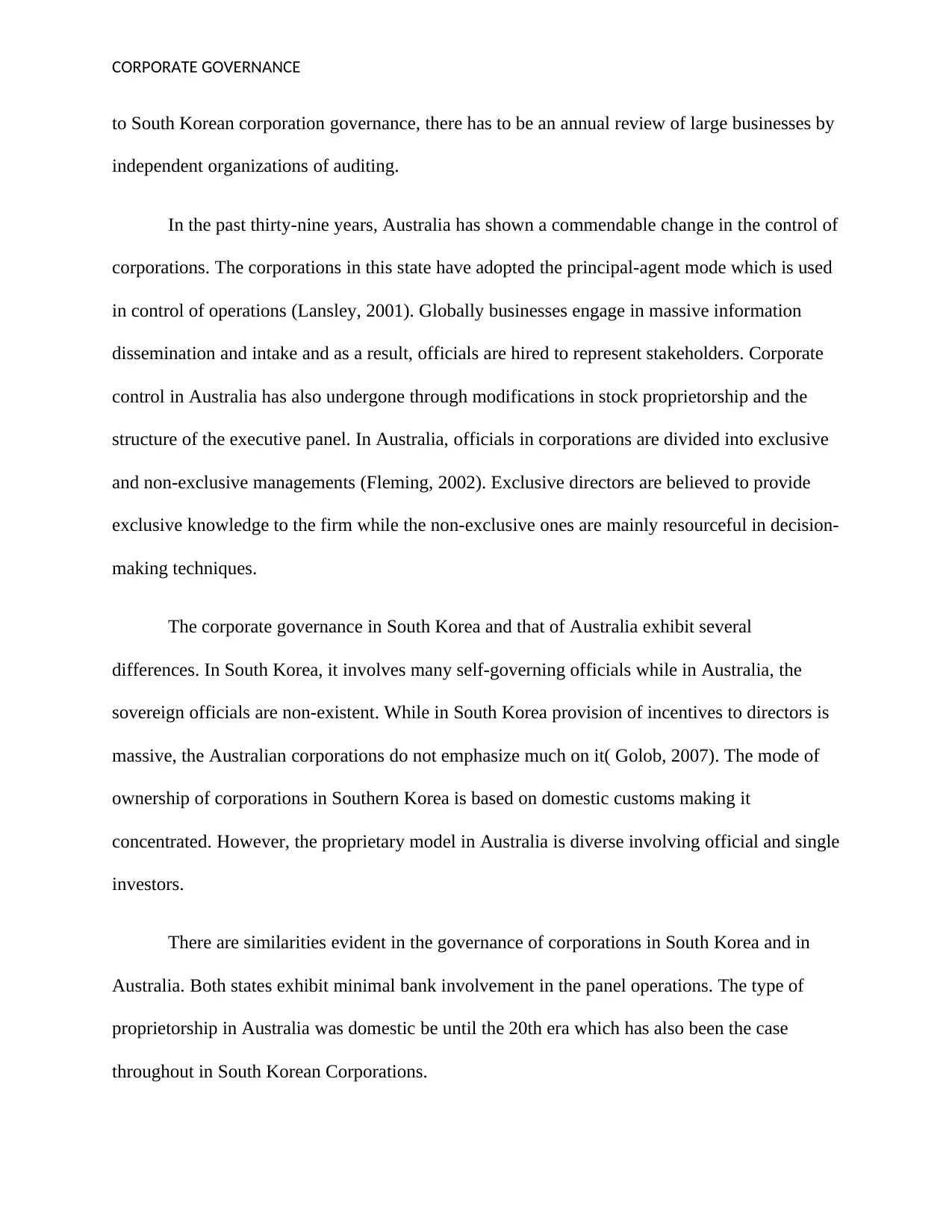
CORPORATE GOVERNANCE
to South Korean corporation governance, there has to be an annual review of large businesses by
independent organizations of auditing.
In the past thirty-nine years, Australia has shown a commendable change in the control of
corporations. The corporations in this state have adopted the principal-agent mode which is used
in control of operations (Lansley, 2001). Globally businesses engage in massive information
dissemination and intake and as a result, officials are hired to represent stakeholders. Corporate
control in Australia has also undergone through modifications in stock proprietorship and the
structure of the executive panel. In Australia, officials in corporations are divided into exclusive
and non-exclusive managements (Fleming, 2002). Exclusive directors are believed to provide
exclusive knowledge to the firm while the non-exclusive ones are mainly resourceful in decision-
making techniques.
The corporate governance in South Korea and that of Australia exhibit several
differences. In South Korea, it involves many self-governing officials while in Australia, the
sovereign officials are non-existent. While in South Korea provision of incentives to directors is
massive, the Australian corporations do not emphasize much on it( Golob, 2007). The mode of
ownership of corporations in Southern Korea is based on domestic customs making it
concentrated. However, the proprietary model in Australia is diverse involving official and single
investors.
There are similarities evident in the governance of corporations in South Korea and in
Australia. Both states exhibit minimal bank involvement in the panel operations. The type of
proprietorship in Australia was domestic be until the 20th era which has also been the case
throughout in South Korean Corporations.
to South Korean corporation governance, there has to be an annual review of large businesses by
independent organizations of auditing.
In the past thirty-nine years, Australia has shown a commendable change in the control of
corporations. The corporations in this state have adopted the principal-agent mode which is used
in control of operations (Lansley, 2001). Globally businesses engage in massive information
dissemination and intake and as a result, officials are hired to represent stakeholders. Corporate
control in Australia has also undergone through modifications in stock proprietorship and the
structure of the executive panel. In Australia, officials in corporations are divided into exclusive
and non-exclusive managements (Fleming, 2002). Exclusive directors are believed to provide
exclusive knowledge to the firm while the non-exclusive ones are mainly resourceful in decision-
making techniques.
The corporate governance in South Korea and that of Australia exhibit several
differences. In South Korea, it involves many self-governing officials while in Australia, the
sovereign officials are non-existent. While in South Korea provision of incentives to directors is
massive, the Australian corporations do not emphasize much on it( Golob, 2007). The mode of
ownership of corporations in Southern Korea is based on domestic customs making it
concentrated. However, the proprietary model in Australia is diverse involving official and single
investors.
There are similarities evident in the governance of corporations in South Korea and in
Australia. Both states exhibit minimal bank involvement in the panel operations. The type of
proprietorship in Australia was domestic be until the 20th era which has also been the case
throughout in South Korean Corporations.
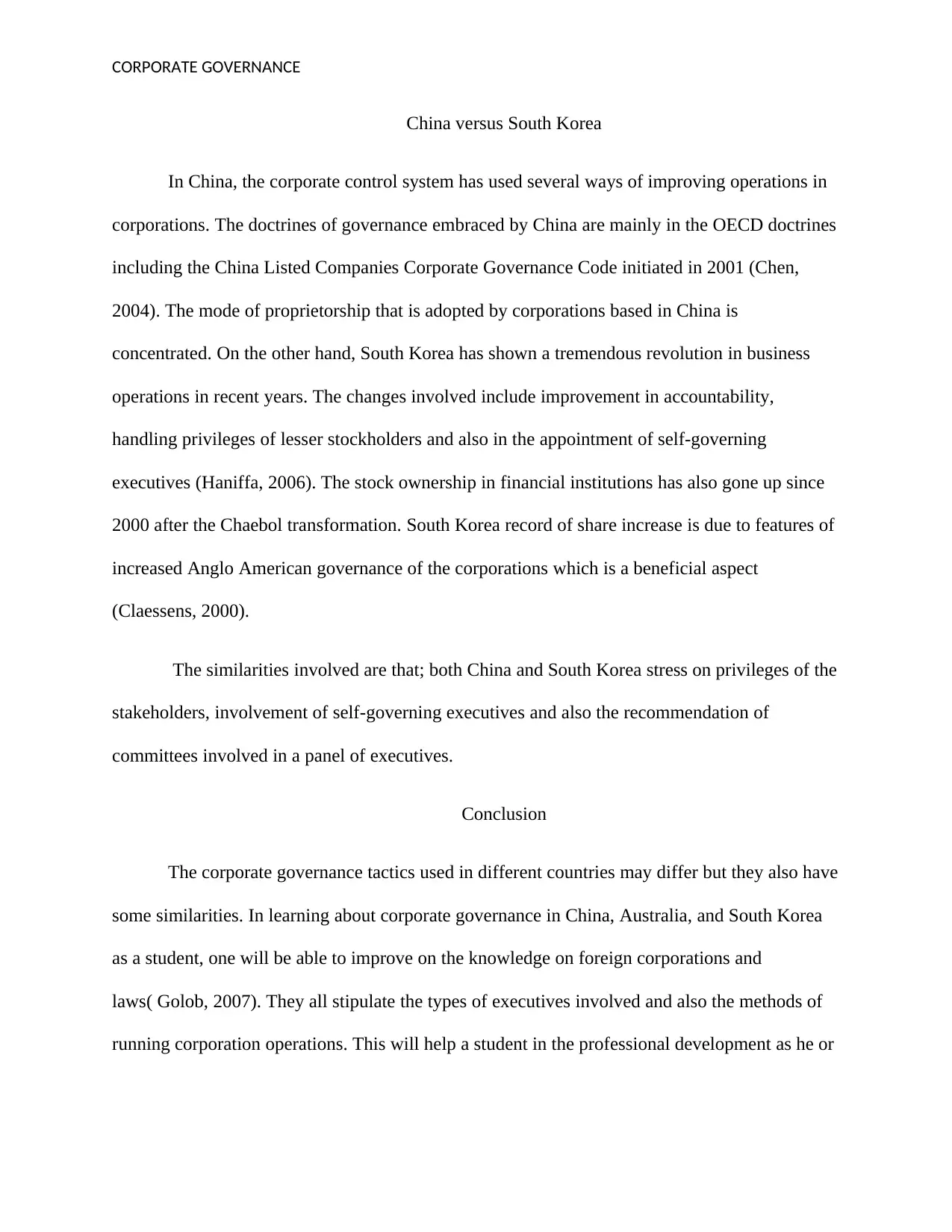
CORPORATE GOVERNANCE
China versus South Korea
In China, the corporate control system has used several ways of improving operations in
corporations. The doctrines of governance embraced by China are mainly in the OECD doctrines
including the China Listed Companies Corporate Governance Code initiated in 2001 (Chen,
2004). The mode of proprietorship that is adopted by corporations based in China is
concentrated. On the other hand, South Korea has shown a tremendous revolution in business
operations in recent years. The changes involved include improvement in accountability,
handling privileges of lesser stockholders and also in the appointment of self-governing
executives (Haniffa, 2006). The stock ownership in financial institutions has also gone up since
2000 after the Chaebol transformation. South Korea record of share increase is due to features of
increased Anglo American governance of the corporations which is a beneficial aspect
(Claessens, 2000).
The similarities involved are that; both China and South Korea stress on privileges of the
stakeholders, involvement of self-governing executives and also the recommendation of
committees involved in a panel of executives.
Conclusion
The corporate governance tactics used in different countries may differ but they also have
some similarities. In learning about corporate governance in China, Australia, and South Korea
as a student, one will be able to improve on the knowledge on foreign corporations and
laws( Golob, 2007). They all stipulate the types of executives involved and also the methods of
running corporation operations. This will help a student in the professional development as he or
China versus South Korea
In China, the corporate control system has used several ways of improving operations in
corporations. The doctrines of governance embraced by China are mainly in the OECD doctrines
including the China Listed Companies Corporate Governance Code initiated in 2001 (Chen,
2004). The mode of proprietorship that is adopted by corporations based in China is
concentrated. On the other hand, South Korea has shown a tremendous revolution in business
operations in recent years. The changes involved include improvement in accountability,
handling privileges of lesser stockholders and also in the appointment of self-governing
executives (Haniffa, 2006). The stock ownership in financial institutions has also gone up since
2000 after the Chaebol transformation. South Korea record of share increase is due to features of
increased Anglo American governance of the corporations which is a beneficial aspect
(Claessens, 2000).
The similarities involved are that; both China and South Korea stress on privileges of the
stakeholders, involvement of self-governing executives and also the recommendation of
committees involved in a panel of executives.
Conclusion
The corporate governance tactics used in different countries may differ but they also have
some similarities. In learning about corporate governance in China, Australia, and South Korea
as a student, one will be able to improve on the knowledge on foreign corporations and
laws( Golob, 2007). They all stipulate the types of executives involved and also the methods of
running corporation operations. This will help a student in the professional development as he or
⊘ This is a preview!⊘
Do you want full access?
Subscribe today to unlock all pages.

Trusted by 1+ million students worldwide
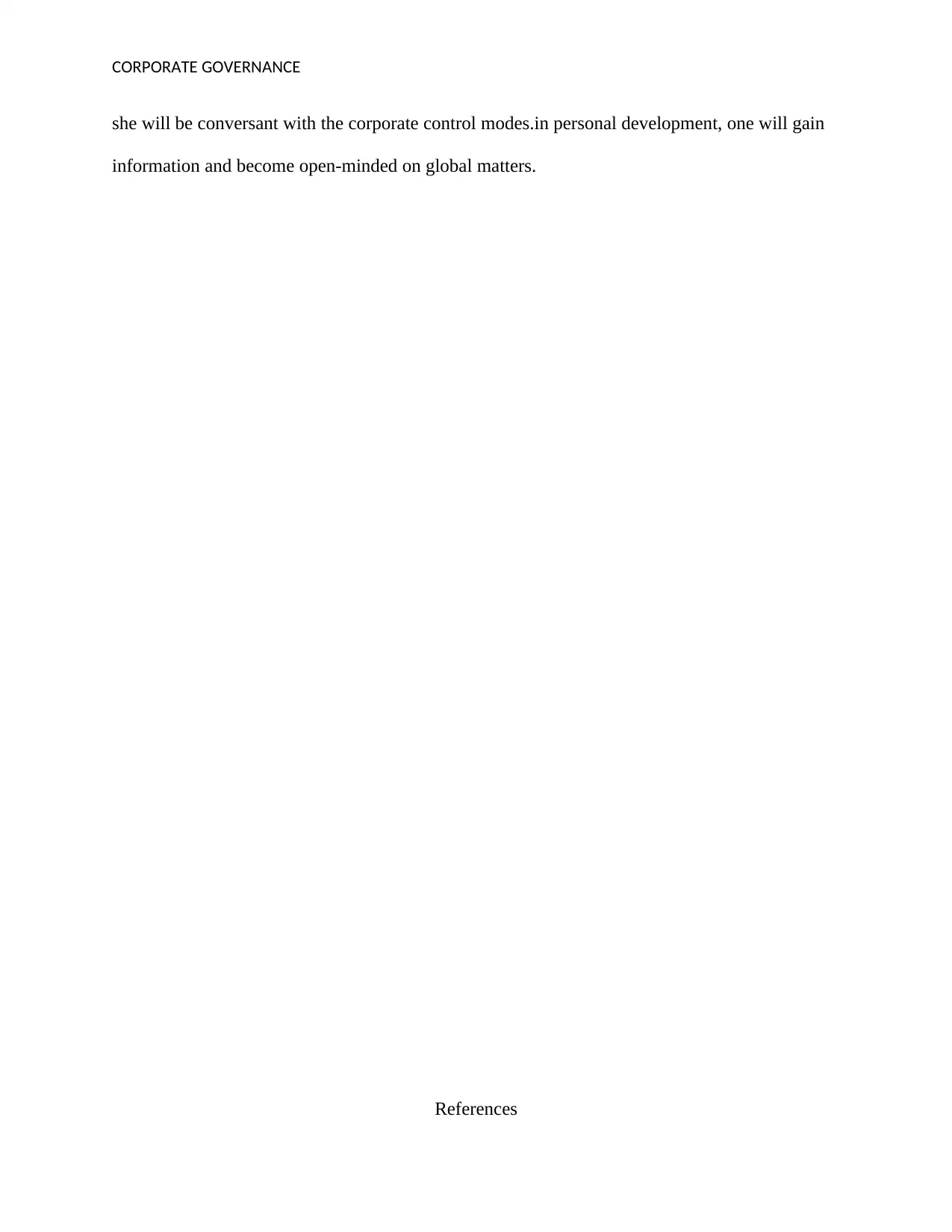
CORPORATE GOVERNANCE
she will be conversant with the corporate control modes.in personal development, one will gain
information and become open-minded on global matters.
References
she will be conversant with the corporate control modes.in personal development, one will gain
information and become open-minded on global matters.
References
Paraphrase This Document
Need a fresh take? Get an instant paraphrase of this document with our AI Paraphraser
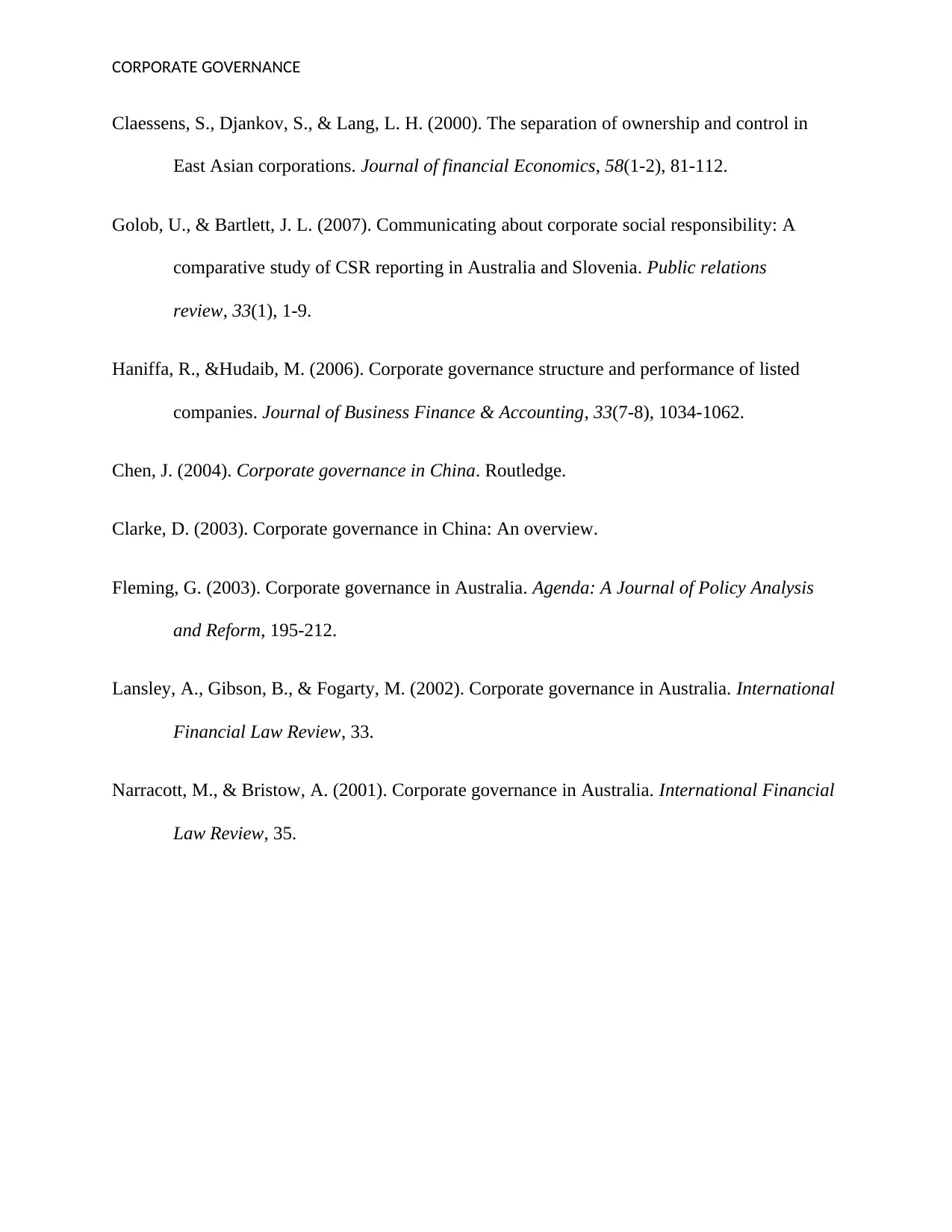
CORPORATE GOVERNANCE
Claessens, S., Djankov, S., & Lang, L. H. (2000). The separation of ownership and control in
East Asian corporations. Journal of financial Economics, 58(1-2), 81-112.
Golob, U., & Bartlett, J. L. (2007). Communicating about corporate social responsibility: A
comparative study of CSR reporting in Australia and Slovenia. Public relations
review, 33(1), 1-9.
Haniffa, R., &Hudaib, M. (2006). Corporate governance structure and performance of listed
companies. Journal of Business Finance & Accounting, 33(7‐8), 1034-1062.
Chen, J. (2004). Corporate governance in China. Routledge.
Clarke, D. (2003). Corporate governance in China: An overview.
Fleming, G. (2003). Corporate governance in Australia. Agenda: A Journal of Policy Analysis
and Reform, 195-212.
Lansley, A., Gibson, B., & Fogarty, M. (2002). Corporate governance in Australia. International
Financial Law Review, 33.
Narracott, M., & Bristow, A. (2001). Corporate governance in Australia. International Financial
Law Review, 35.
Claessens, S., Djankov, S., & Lang, L. H. (2000). The separation of ownership and control in
East Asian corporations. Journal of financial Economics, 58(1-2), 81-112.
Golob, U., & Bartlett, J. L. (2007). Communicating about corporate social responsibility: A
comparative study of CSR reporting in Australia and Slovenia. Public relations
review, 33(1), 1-9.
Haniffa, R., &Hudaib, M. (2006). Corporate governance structure and performance of listed
companies. Journal of Business Finance & Accounting, 33(7‐8), 1034-1062.
Chen, J. (2004). Corporate governance in China. Routledge.
Clarke, D. (2003). Corporate governance in China: An overview.
Fleming, G. (2003). Corporate governance in Australia. Agenda: A Journal of Policy Analysis
and Reform, 195-212.
Lansley, A., Gibson, B., & Fogarty, M. (2002). Corporate governance in Australia. International
Financial Law Review, 33.
Narracott, M., & Bristow, A. (2001). Corporate governance in Australia. International Financial
Law Review, 35.
1 out of 8
Your All-in-One AI-Powered Toolkit for Academic Success.
+13062052269
info@desklib.com
Available 24*7 on WhatsApp / Email
![[object Object]](/_next/static/media/star-bottom.7253800d.svg)
Unlock your academic potential
Copyright © 2020–2025 A2Z Services. All Rights Reserved. Developed and managed by ZUCOL.
